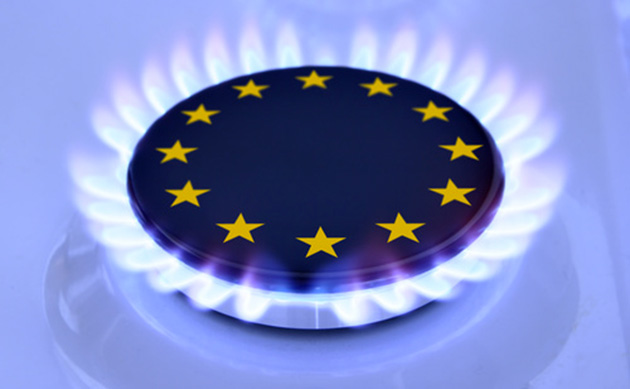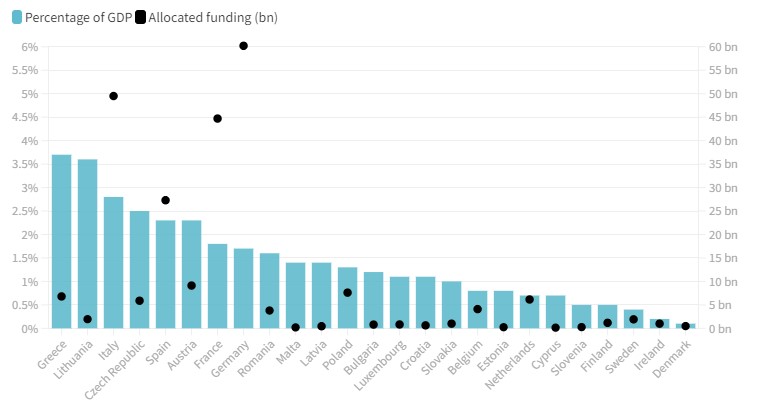Dear energy, this is how much Italy and Europe are spending more

A study by Bruegel analyzed measures and funds allocated by European countries to mitigate the energy price crisis: Italy has so far spent 49.5 billion, 2.8% of GDP. All the details
According to a study by the Brussels think tank Bruegel, European countries have allocated around 280 billion euros in funds to mitigate the impact of the energy crisis on households and businesses.
THE CONTEXT
Wholesale energy prices are more than ten times higher than the seasonal average of the last five years: one of the main causes is the limitation of gas supplies from Russia – which in 2021 alone was the source of 40 per percent of imports at the European level -, even before the start of the war in Ukraine.
High energy prices particularly affect heavy and energy- intensive industries, but high bills and inflation are also affecting citizens' spending power. In Italy, the Arera (Regulatory Authority for Energy, Networks and the Environment) has anticipated the possibility of an "increase of over 100 percent compared to the current quarter" in energy bills starting from next October.
WHAT SGARAVATTI (BRUEGEL) THINKS
Giovanni Sgaravatti, Bruegel's analyst and co-author of the study, told Bloomberg that "prices will remain high throughout the winter and governments should work with the worst-case scenario hypothesis, which is that they will not go down even after". "Governments," he added, "should focus on reducing energy demand wherever possible."
– Read also: Who, how and why asks to ration energy
WHAT THE INTERNATIONAL MONETARY FUND SAYS
Three experts from the International Monetary Fund, Olya Celasun, Dora Iakova and Ian Parry, wrote in recent days that "European policy makers have responded to the surge in energy costs, especially with far-reaching and price containment measures, including subsidies , tax cuts and price controls ”. The three analysts think that these measures are not facilitating the reduction of energy consumption, on the contrary keeping "global energy demand and prices higher than they would otherwise be".
WHO HAS SPENT MORE
Bruegel's study examines the funds allocated by European countries from September 2021 to July 2022 through various measures to reduce the economic impacts of expensive energy.

The country that allocated the most resources – not all of which have necessarily already been spent – was Germany, with 60.2 billion euros, equal to 1.7 percent of its GDP. Followed by Italy with 49.5 billion (2.8 per cent of GDP) and France with 44.7 (1.8 per cent of GDP).
The three countries that spent the most in relation to GDP were, in order, Greece (6.8 billion, equal to 3.7 percent of GDP), Lithuania (2 billion and 3.6 percent of GDP ) and Italy.
HOW MUCH AND HOW ITALY SPENT
Bruegel recalls how on 27 September the Italian government approved short-term measures of 3 billion euros to compensate for the increase in electricity and gas prices until the end of 2021, also using the proceeds of the auction for quotas of CO2 .
Then, on 18 December, the government described the spending methods for 2022: 1.8 billion for the elimination of system charges for electricity users; 480 million to cancel the charges on gas bills; 912 million for the increase in social bonuses for families in conditions of economic and social vulnerability.
On January 21, 2022, the Council of Ministers announced new 1.7 billion measures against high bills, with a tax credit of 20 percent for all energy-intensive companies that experienced a 30 percent increase in energy prices compared to 2019: the measure was partly financed with a tax on the profits of renewable producers (wind, photovoltaic, hydroelectric, geothermal).
On March 19, a new 4.4 billion package was approved to extend the social bonus to 5.2 million home users and to reduce the price of gasoline by 25 cents until the end of April, all financed with a tax. 10 per cent on energy companies.
On April 21, the Senate approved an extra € 8 billion spending; of these, 5.5 billion were destined to counter the rise in energy prices and the rest to support the productive sectors most affected by the crisis. System charges on utility bills were zeroed throughout the summer and VAT on gas bills raised to 5 percent. The air cooling systems should not have dropped below 25 ° C throughout the summer season.
On 2 May, Prime Minister Mario Draghi presented a 14 billion euro package in support of families and businesses. It also aimed to speed up the commissioning of renewable energy and regasification plants and to cut 30 cents per liter of petrol and diesel. The measures contained in the package were mainly financed through the increase in the tax on energy companies, from 10 to 25 percent.
At the end of June, a new 3 billion decree was approved to reduce the increase in bills, extending some old measures such as the reduction of VAT on gas bills to 5 percent. Among the innovations was the maintenance of the system charges for the gas sector unaltered by ARERA, at a cost of 292 million. The decree also linked the social bonus for electricity and gas to the value of the ISEE, to direct aid to the slice of the population in greater economic difficulty. Finally, it contained provisions to encourage the filling of gas storage sites.
Towards the end of July, the Aid bis decree (from 15 billion) allocated over 6 billion to cover the extension of the measures already adopted (the 5 percent cut in VAT on gas and the cost of fuel by 30 cents per liter , for instance). Municipalities and metropolitan cities received 350 and 50 million respectively to meet the increase in energy costs. The transport sector obtained another 101 million, compared to the 79 already allocated in the previous months of 2022.
THE EXPENDITURE FOR REGASIFIERS
In June Snam – the energy company (owned by Cassa Depositi e Prestiti) that manages the Italian pipeline network – spent 330 million for the purchase of a regasification vessel, the Golar Tundra , which will allow Italy to receive more amount of liquefied gas to replace Russian supplies.
In May, Snam had also purchased another ship to be converted into a regasification plant, the Golar Arctic , at a price of 269 million. Finally, in July, it bought a third regasification unit, BW Singapore , for 400 million.
– Read also: Regasifiers, this is how the government will push Snam, Enel, Iren and Sorgenia
This is a machine translation from Italian language of a post published on Start Magazine at the URL https://www.startmag.it/energia/caro-energia-spesa-italia-europa/ on Thu, 25 Aug 2022 10:02:23 +0000.
